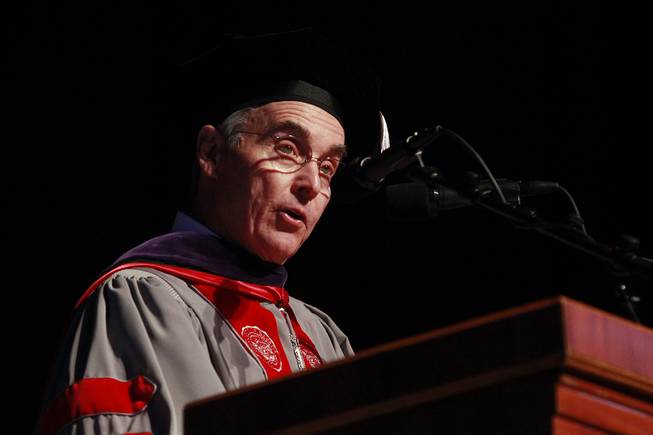
Sam Morris / Las Vegas Sun
UNLV acting president Don Snyder speaks during commencement ceremonies Saturday, May 17, 2014.
Sunday, Aug. 24, 2014 | 2 a.m.
View more of the Sun's opinion section
Editor’s note: For August, Brian Greenspun has invited some members of the community to talk about the issues important to them. Today’s column is by Don Snyder, who became the 10th UNLV president in February when Neal Smatresk resigned to take the helm of the University of North Texas.
As UNLV starts a new academic year Monday by welcoming nearly 30,000 students to campus, it is evident the university is evolving. Yes, there is enormous change occurring at UNLV, and there is also excitement as we look to the future. While the potential of a new UNLV School of Medicine and a possible new stadium on or near campus have generated most of the headlines, those initiatives are all part of a larger vision.
At the core of that vision is the “Path to Tier One. ” The dialogue around the vision has generated tremendous energy and understanding among various stakeholders about why it is needed. Tier One (Carnegie Research / Very High) universities are research-focused institutions with overall academic excellence. They attract the best and brightest students, are committed to student success, receive more federal grants and generate more economic development for a community and a state. For example, the investment in research at Tier One universities often facilitates startup companies and enhances workforce development by graduating students with broad, versatile expertise. Las Vegas is one of the few major metropolitan areas without a Tier One university, and no institution in Nevada currently holds Carnegie’s top classification. In fact, only 2 percent of all higher-education institutions in the country have the designation, and only 75 are public universities.
Former UNLV President Carol Harter first introduced the greater focus for UNLV becoming a more research-based institution, and the concept was further defined by President Neal Smatresk as Tier One. The “Path to Tier One” is neither easy, nor quick, but it is well worth the long-term investment. If UNLV is to compete regionally and nationally, it must become a Tier One university. If we want our students and our alumni to be recognized for the excellence of their education, we must continue to move forward on this path. If we want to be recognized for our research, gaming innovation and regulation, unmanned autonomous systems (i.e., drones), information technology, health and medical services and analytics, and science and technology, then we must be at the forefront. And if we want to have a stronger link to private industry in Las Vegas and throughout Nevada, then we must become more flexible and entrepreneurial. All these characteristics reflect Tier One. Business leaders as well as elected officials, both at the state and federal levels, have embraced this initiative.
We formally have started the process to make our vision a reality. Earlier this year, we analyzed other institutions that have achieved Tier One status such as Central Florida in Orlando, which has a tourism-based economy like Las Vegas. We have also have spoken with the chancellor of the University of Houston System, Renu Khator. Recently, a few of us also traveled to Phoenix for a day to have face-to-face meetings with Arizona State University (ASU) President Michael Crow and his leadership team. The trip also included a tour of ASU’s facilities. This summer, we hired outside consultants, all with experience at the University of Southern California, to help us develop a strategic plan that will lead us on our “Path to Tier One.” The first phase of their work is to conduct a critical assessment of UNLV’s present situation, analyzing our organizational structure and accompanying infrastructure, identifying gaps and developing a road map to help us achieve our goal. Simultaneously, we are forming a steering committee and a campus engagement committee of faculty, professional and classified staff who will work on a parallel path to analyze the vision from an internal perspective. Collectively, we want to fully develop a strategic plan during the 2014-15 academic year to benefit both the university and the next UNLV president.
Nearly 60 years ago, UNLV opened its doors to the community. Much like Southern Nevada, UNLV has grown and evolved over that time, but there is still much for us to achieve. I have always believed that you cannot have a great community without a great university, connected to that community and beyond. To be the university that our community needs, our students need and private industry needs, we must become a Carnegie Research “Very High” Tier One university. Las Vegas has never been a community that stands still. It continues to move forward. For UNLV to achieve its current and aspirational goals, we must work collaboratively and in concert with the community as a whole. We must engage the community, and in turn, the community will embrace UNLV. Our future success depends on it.
Don Snyder is president of UNLV.

Join the Discussion:
Check this out for a full explanation of our conversion to the LiveFyre commenting system and instructions on how to sign up for an account.
Full comments policy